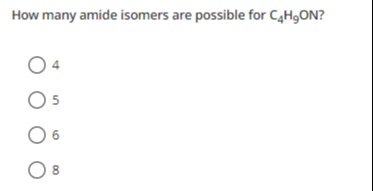Question
Question: How many amide isomers are possible for $C_4H_9ON$?...
How many amide isomers are possible for C4H9ON?

4
5
6
8
8
Solution
The molecular formula given is C4H9ON. We are looking for the number of amide isomers with this formula. An amide functional group is −CO−N<. The formula C4H9ON has a degree of unsaturation of 1, which is accounted for by the C=O double bond in the amide group.
The general structure of an amide is R1−CO−N(R2)R3, where R1, R2, and R3 can be hydrogen atoms or alkyl groups. The carbon in the carbonyl group is already accounted for. We have 3 additional carbon atoms (C3) and the remaining hydrogen atoms to distribute among R1, R2, and R3. The total number of carbon atoms in R1, R2, and R3 must sum up to 3.
We can classify amides based on the number of alkyl groups attached to the nitrogen atom:
-
Primary amides: R2=H, R3=H. The structure is R1−CO−NH2. The group R1 must contain 3 carbon atoms. The possible alkyl groups with 3 carbons (C3H7) are n-propyl (CH3CH2CH2−) and isopropyl ((CH3)2CH−).
- CH3CH2CH2−CO−NH2 (Butanamide)
- (CH3)2CH−CO−NH2 (2-Methylpropanamide)
There are 2 primary amide isomers.
-
Secondary amides: One alkyl group (R2) and one hydrogen (R3=H) attached to nitrogen. The structure is R1−CO−NH−R2, where R2 is an alkyl group. The total number of carbon atoms in R1 and R2 must be 3, and R2 must have at least one carbon.
-
Case 2a: R1=H. R2 must contain 3 carbons (C3H7). Possible R2 groups are n-propyl and isopropyl.
- H−CO−NH−CH2CH2CH3 (N-Propylformamide)
- H−CO−NH−CH(CH3)2 (N-Isopropylformamide)
(2 isomers)
-
Case 2b: R1 contains 1 carbon (CH3−). R2 must contain 2 carbons (C2H5−).
- CH3−CO−NH−CH2CH3 (N-Ethylacetamide)
(1 isomer)
-
Case 2c: R1 contains 2 carbons (C2H5−). R2 must contain 1 carbon (CH3−).
- CH3CH2−CO−NH−CH3 (N-Methylpropanamide)
(1 isomer)
-
Case 2d: R1 contains 3 carbons (C3H7−). R2 must contain 0 carbons, which is not an alkyl group. This case is not possible for secondary amides.
There are 2+1+1=4 secondary amide isomers.
-
-
Tertiary amides: Two alkyl groups (R2 and R3) attached to nitrogen. The structure is R1−CO−N(R2)R3, where R2 and R3 are alkyl groups. The total number of carbon atoms in R1, R2, and R3 must be 3, and R2,R3 must each have at least one carbon.
-
Case 3a: R1=H. R2 and R3 must distribute the 3 carbons, with at least 1 carbon each. The only possible distribution is 1 carbon and 2 carbons.
- R2=CH3− and R3=C2H5− (or vice versa).
- H−CO−N(CH3)(C2H5) (N-Ethyl-N-methylformamide)
(1 isomer)
-
Case 3b: R1 contains 1 carbon (CH3−). R2 and R3 must distribute the remaining 2 carbons, with at least 1 carbon each. The only possible distribution is 1 carbon and 1 carbon.
- R2=CH3− and R3=CH3−.
- CH3−CO−N(CH3)2 (N,N-Dimethylacetamide)
(1 isomer)
-
Case 3c: R1 contains 2 carbons (C2H5−). R2 and R3 must distribute the remaining 1 carbon, with at least 1 carbon each. Not possible.
-
Case 3d: R1 contains 3 carbons (C3H7−). R2 and R3 must distribute the remaining 0 carbons, with at least 1 carbon each. Not possible.
There are 1+1=2 tertiary amide isomers.
-
Total number of amide isomers = Number of primary amides + Number of secondary amides + Number of tertiary amides Total isomers = 2 + 4 + 2 = 8.
The 8 isomers are:
- Butanamide (CH3CH2CH2CONH2)
- 2-Methylpropanamide ((CH3)2CHCONH2)
- N-Ethylacetamide (CH3CONHCH2CH3)
- N-Methylpropanamide (CH3CH2CONHCH3)
- N-Propylformamide (HCONHCH2CH2CH3)
- N-Isopropylformamide (HCONHCH(CH3)2)
- N-Ethyl-N-methylformamide (HCON(CH3)(C2H5))
- N,N-Dimethylacetamide (CH3CON(CH3)2)
